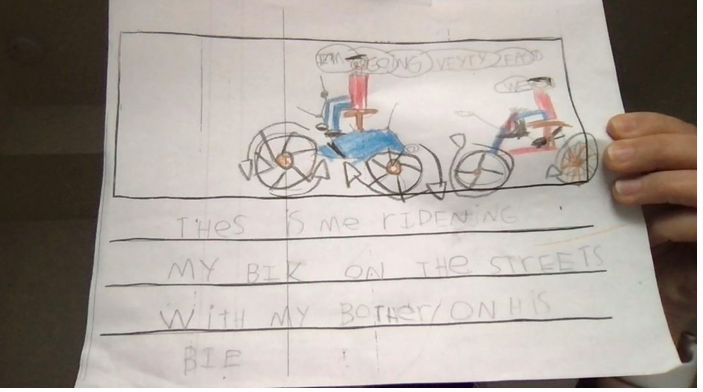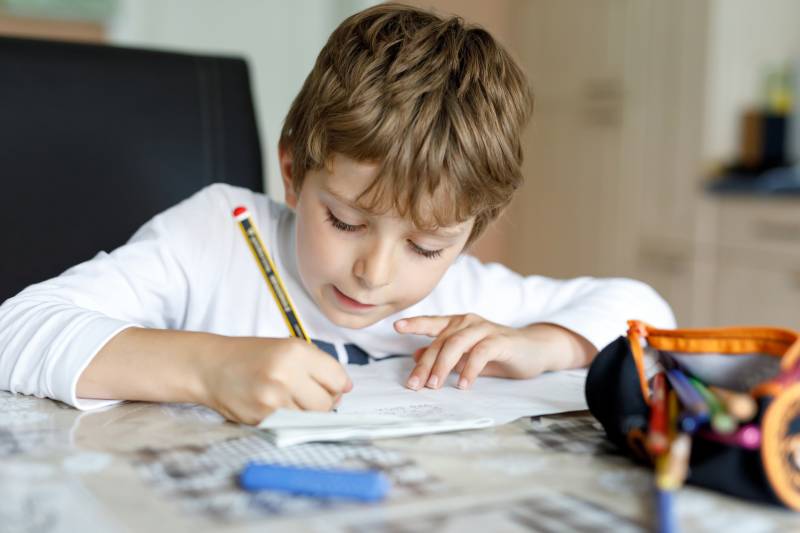The act of physically writing builds fine motor skills, which is important for future academic success. Early development of motor skills – as utilized in motor coordination, executive function and visuospatial skills – are necessary for future academic achievement, according to a 2016 report.
To help kids who don’t get this kind of practice at home, early grade curriculum should structure activities purposefully aimed at developing motor skills, along with executive function, socio-emotional skills and general knowledge, which is what kids use to make sense of the world. That’s according to one of the paper’s authors, David Grissmer, a research professor at the University of Virginia.
“These are the four kind of building-block skills that are needed for kids to do well in school,” said Grissmer. “If they develop these skills during early childhood and have a good developmental path for these skills by the time they start school, they are much more likely to do better in school.”
Courtney Miller’s son is in kindergarten at Glen Cove Elementary in Vallejo, California. His school provided a touchscreen device for class assignments, which eased his online navigation and reduced some of the initial technical challenges he faced on a traditional laptop. While he typically used a pencil and paper during class, he would use the touchscreen to complete homework, including assignments that involve tracing letters on screen, though the tracing assignments can glitch.
“When you’re doing spelling and you’re tracing words on a touchscreen, sometimes it can get a little finicky and it doesn’t work,” said Miller.
In her virtual kindergarten classroom, Glick helped her students remember each letter by telling a story about how to write it.
“‘B’ is made with a dive-down letter. So you dive down,” Glick said as she deepened her voice. “Then you swim up and then over. That kind of language helps imprint the formation of the letter in their brains.”
This was Glick’s sixth year of teaching kindergarten. Compared with previous years, her students’ mastery of writing their letters seemed to take more time — a potential effect of both decreased instruction time and the missing in-person assistance and observation of a classroom.
“It’s really hard to see how the kids are actually forming the letters and how they’re holding their pencils,” Glick said. “I’m imagining that the first grade teachers will be having a lot of interesting console grips.”
Supporting Parents is Supporting Kids
During in-person instruction, Vikram Nahal would directly correct console grips in his role as a Resource Specialist Program (RSP) teacher in Northern California. He could provide grip tools for pencils or guide students’ hands with his own. During virtual education, he relied on reference materials and parent assistance when available to demonstrate grips, steer hands and inform him when additional resources were needed — all to ensure his students’ mastery of literacy building blocks.
And due to virtual learning, many students gained technological skills that they might not have otherwise gleaned.
“They’ve got to be computer literate. It’s a literacy issue for me,” Nahal said, noting that access to technology is an equity concern.
At Miller’s school, the technical support and distance learning workshops help parents with technology. Glen Cove Elementary teachers offer daily office hours and Vallejo City Unified School District offers a weekly parent hour for tech-related advice and questions.
Writing Means Reading and Listening
Vera Ahiyya, a kindergarten teacher in Brooklyn, New York, learned through educators on social media that many publishing houses relaxed their permission requirements for online recordings of children’s books during the pandemic. In spring 2020, Ahiyya and her colleagues took turns uploading videos of themselves reading children’s books to their school’s web drive.
Ahiyya could also attach questions relating to certain time stamps. These pre-recorded videos provided narration uninterrupted with their frames displaying well-lit, close-up pages. Students could take their time, pause and rewatch videos, something that they couldn’t do, or couldn’t do as easily, during read-alouds in person. Parents told her they appreciated the online library provided by the collected videos.
“It can be a great way for students who might have processing delays, who might have visual or auditory processing needs. They can get a second chance, a second go at experiencing the book,” said Ahiyya. “Online, they can kind of stop and take their time and really enjoy the book for what it is as they need it to be.”
Multiple studies have found that the act of reading to young kids is beneficial for early language and literacy skills development. Some research indicates that children with stronger reading abilities also possessed strong phonological processing.
Strong readers tend to be more able to listen to and manipulate phonemes – the individual units of sound – and that further improves reading skills, which in turn strengthens phonological processing in a cyclical process.
And reading aloud to children is more effective than casual conversation when it comes to developing vocabularies. Words that aren’t among the 5,000 most common English words are two to three times more likely than caretaker-child conversations to appear in picture books, meaning that books are more likely to have words children might not hear in their daily lives.
Despite having made progress online, when Ahiyya’s class moved back to in-person learning, she decided she wanted to decrease technology use and move back to analogue learning. She emphasized tactile and creative activities they couldn’t do, or couldn’t do as easily, during virtual learning.
“We also wanted to give them time to create and build mobility in their fingers, in their hands, in a way that they hadn’t been able to do when they were learning remotely,” Ahiyya said.



